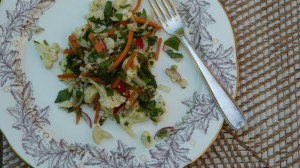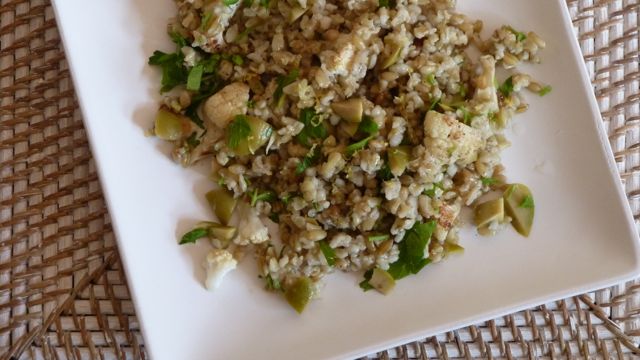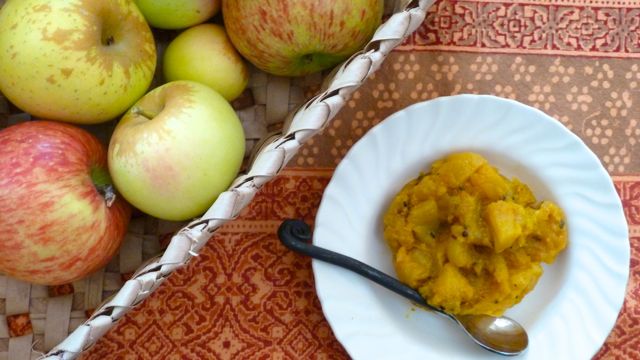This week my in-laws (known in Hindi as Dadi and Dada to our teenage girls) join us in the kitchen. It’s always a treat to welcome more cooks into the action especially those that bring love and laughter, along with creative, tasty ideas. There’s plenty of elbow room for all, along with knives and cutting boards. Great meals are guaranteed.
Most of what we’ve been mixing up these last few days qualifies as Indian food, even if not strictly so. You can always doctor up pizza Margherita with a few strips of ginger root and chopped cilantro leaves, nestle mustard seed-studded pepper achar (pickle) on a sandwich or sprinkle garam masala spice over roasted winter squash. That way each tastes a bit more, well, Indian. And better.  My husband’s parents have lived in Iowa for more than forty years, but still steadfastly adore the food of their native land more than any other. And who can blame them? Dressed up with bold, aromatic spices and a hint of fiery pepper—there’s nothing that could taste more satisfying to us right now. After seven days of cooking together, our kitchen is painted with layers of heady, spiced-infused scent. One step inside conjures up vivid daydreams of meals we’ve savored thus far, and foreshadows those yet to come.
My husband’s parents have lived in Iowa for more than forty years, but still steadfastly adore the food of their native land more than any other. And who can blame them? Dressed up with bold, aromatic spices and a hint of fiery pepper—there’s nothing that could taste more satisfying to us right now. After seven days of cooking together, our kitchen is painted with layers of heady, spiced-infused scent. One step inside conjures up vivid daydreams of meals we’ve savored thus far, and foreshadows those yet to come.
Among the highlights in my mother-in-law’s culinary bag of tricks—and something she shared this week—is her chutney. It’s legendary, though her formula is surprisingly simple. And adapts to virtually any fruit of the season. We pick whatever hangs lowest on the tree at the moment. Summer is gooey apricots, and in October what else would we choose but nature’s most abundant fall sweet? The one piled in baskets and bags across the kitchen. All-American apples.
At the heart of all her chutneys, no matter the fruit, is a blend of whole spices called Panch-Phoran, which means “five spices”. The blend includes cumin, fennel, black mustard, kalonji and fenugreek seeds. No doubt you’re familiar with cumin (jeera) seeds—brown and oblong with sharp points on either end. Fennel (saunf) looks like a distant cousin, but with a casing more green than brown and a distinctive licorice flavor all its own. Black mustard seeds (raayi) are dark brown balls the size of pin heads, universally appreciated for their elfin crunch. Kalonji (also known as nigella and black onion seed) are charcoal-colored bits that look like Halloween-ready sesame seeds. You might notice the dark flecks on puffy tandoor-baked flatbreads (naan) served at finer restaurants. Golden and squarish in shape, fenugreek (methi) seeds are wonderfully flavorful when roasted or sautéed, though bitter when raw. All five spices are valued in India and many other countries, for therapeutic purposes as well as what each adds in taste to food. (Click on each word highlighted in blue above for links to detailed information.)
In Indian cooking whole spices are typically dry-roasted or cooked in oil until they become fragrant and deepen in color—before the main ingredients are added to the pan. This process imparts a nutty depth of flavor, as well as a tantalizing aroma to the kitchen. Next time you cook an Indian dish try roasting the spices as the first step. Nothing longer than 30 seconds though, or you’re likely to end up with burnt bits.
Apple Chutney
Look for Panch-Phoran at any Indian grocery store. If you’re unable to locate the spice blend, you can substitute the individual whole spices (use as many as you have) in the amounts listed in the recipe. Most of the whole spices as well as the ground ones, can be sourced at Whole Foods or high-end markets (except perhaps the kalonji or fenugreek), and many are now readily available at ordinary grocery chains as well.
You can follow this basic recipe for other types of fruit chutneys—just substitute an equal amount of fruit. Use those that cook up well, as evidenced in jams and jellies. A favorite of ours is apricot—softer and more spreadable than its chunky fall counterpart. Sweet peach is also perfect for summer.
Besides serving as a condiment with all sorts of Indian dishes, try spreading this chutney on toasted bread and crackers, or layering in a cheddar cheese sandwich. I’ve been told it’s a perfect accompaniment to roast pork as well.
Yields about 3 cups
Ingredients:
- Neutrally flavored oil (such as canola)
- 3 1/2 teaspoons Panch-Phoran (or 1 teaspoon cumin seed, 1/2 teaspoon fennel seed, 1 teaspoon black mustard seeds, 1/2 teaspoon fenugreek seeds, 1/2 teaspoon kalonji)
- 6 cups cubed apples
- 1/2 teaspoon ground turmeric
- 1/2 teaspoon cayenne powder (or to taste)
- 2 teaspoons ground coriander
- 1/2 teaspoon ground garam masala
- 2 teaspoons sea salt
- Granulated sugar (the least processed variety you have—for instance turbinado)
- Fresh lemon juice
Method:
- Heat 2 to 3 tablespoons oil in a large skillet or pot over medium heat. Add the panch-phoran (or whole spices) and cook until the spices begin to sizzle and darken in color, about 30 seconds.
- Add the apples on top of the spices without stirring. Then add turmeric, coriander, garam masala and salt on top of apples. Continue to cook without stirring for 3 to 5 minutes, allowing apples to soften slightly. Stir in spices, and lower heat to medium-low. Cook until apples are soft, but still hold their shape—about 15 to 20 minutes. Stir occasionally. As the mixture cooks the apples with release moisture into the pan, but if the mixture appears too dry (or begins to brown on the bottom), add a splash of water.
- Over low heat add sugar to taste (about 2 to 4 tablespoons depending on the sweetness of the fruit). Then add fresh lemon juice to balance the sugar (about 1 to 2 tablespoons). Add more salt as needed.
- Cool chutney completely, then store in a glass jar in the fridge. It will keep well for a couple of weeks. Alternatively, place in a ziploc bag, removing as much air as possible and freeze for up to 6 months. Defrost before using.
More Recipes for the Week:
Click on words highlighted in blue to link to recipes and other information.
 Cauliflower, arugula and carrots are tossed together in this light and easy slaw (pictured left). Add crunchy cucumber too—the last of the season.
Cauliflower, arugula and carrots are tossed together in this light and easy slaw (pictured left). Add crunchy cucumber too—the last of the season.
Warming Indian spices compliment fall’s firm squashes—the first of which we receive this week. Try a dish inspired by the Indian method of sautéing pumpkin (kadu) with spices and sweetening with a bit of sugar before serving. In this American version (pictured in the small photo, in the body of the article above), winter squash is sprinkled with garam masala (a ground blend that includes cinnamon, clove, cardamom, cumin and other spices), roasted in the oven, then drizzled with maple syrup.
 For a more Italian approach to roasted squash, try this favorite pasta dish (pictured right). Add any greens you have on hand.
For a more Italian approach to roasted squash, try this favorite pasta dish (pictured right). Add any greens you have on hand.
Roasted cauliflower dresses up a simple grain side dish (pictured below). Substitute rice, farro, Israeli couscous or quinoa if you prefer for the more exotic, but wonderfully flavorful and nutritious freekeh. 



